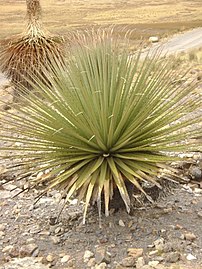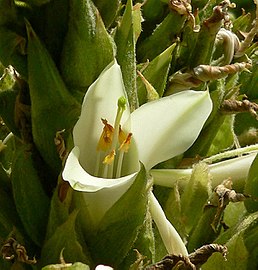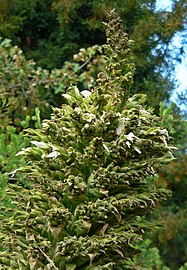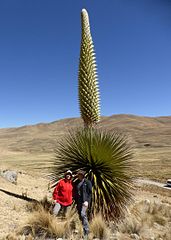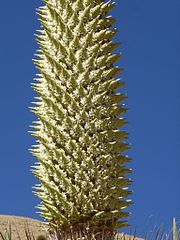Puya raimondii
| Puya raimondii | ||||||||||||
|---|---|---|---|---|---|---|---|---|---|---|---|---|

Habit and inflorescence of Puya raimondii in the habitat . |
||||||||||||
| Systematics | ||||||||||||
|
||||||||||||
| Scientific name | ||||||||||||
| Puya raimondii | ||||||||||||
| Harms |
The Puya raimondii (rarely called giant bromeliad) is a species of the genus Puya within the bromeliad family (Bromeliaceae). It is native to Peru , Bolivia and northern Chile . Puya raimondii thrives at altitudes of 3500 to 4500 meters, especially on sunny and well-watered slopes.
Description and ecology
The Puya raimondii forms the longest inflorescence in the world (up to 8 meters high, depending on the location), which can take a year to form. For this reason, this plant species was entered in the Guinness Book of Records . It has a maximum overall height of 12 meters.
Vegetative characteristics
Puya raimondii grows as a xerophytic , perennial plant . At the age of about 50 to 70 years, the plant specimen has formed an almost spherical rosette of leaves with a diameter of up to 3 meters on an unbranched trunk with a height of about 2 to 5 meters and a diameter of about 0.5 meters. The tough, stiffly protruding, parallel- veined leaves run out into a sharp point; they are 1 to 2 meters long and 6 inches wide. The leaf edge is reinforced with hooked, curved, approximately 1.5 centimeters long spines. The upper side of the leaf is glossy green to reddish, depending on the sunlight, and straw yellow when old; the underside of the leaf is scaly pressed tightly.
Generative characteristics
During the flowering period, Puya raimondii is an impressive sight. The upright inflorescence is composed of numerous racemose partial inflorescences and many bracts with thousands of individual flowers. The thick, hairy flower stalk is about 7 millimeters long.
The hermaphrodite flowers are threefold with a double flower envelope . The three sepals are about 4 inches long and hairy at their base. The three yellowish-green petals are about 5 centimeters long and screw in as they fade. During the prolonged flowering period, hundreds of hummingbirds and other birds can often be seen buzzing around the huge inflorescences.
There are fruit capsules formed in each of many small, flight viable seeds are formed.
Although this plant can live for over 100 years, it only flowers once for about 9 months. After the fruit ripens, the plant specimen slowly dies (this species is therefore hapaxanth ).
Danger
Since the summer of 2016, hundreds of blooming Puya raimondii could be seen for a few months in Peru in the Carpa Valley in the Huascarán National Park at an altitude of about 4500 meters on the way to the Pastoruri Glacier . It is not known that this phenomenon has existed before (see photos below).
In the wild, it has become rare, because despite protection programs it is used as fuel, which is scarce at these altitudes. Often the slopes are burned down as prickly rosettes can pose a threat to grazing cattle. The best place to see this species is in Huascarán National Park (Peru).
Botanical history
The specific epithet raimondii honors the Italian naturalist Antonio Raimondi (1824-1890), who discovered this species in 1867 and published it scientifically in 1874 as Pourretia gigantea (although not described according to the rules). A sketch that was not discovered in the estate until 1949 shows that this species was probably noticed by the Austrian polymath Thaddäus Haenke (1761–1816) as the first European explorer during his research in Bolivia, Peru and Chile.
symbolism
Puya raimondii is the symbol of Peru.
photos
At the natural site:
Fallen plant of Puya raimondii in the San Francisco Botanical Garden:
Puya raimondii , Peru, Carpa Valley in Huascarán National Park, September 2016:
literature
- Werner Rauh : Bromeliads - Tillandsias and other bromeliads worthy of culture . Verlag Eugen Ulmer, Stuttgart 1990, ISBN 3-8001-6371-3 .
- Pierre L. Ibisch: Puya raimondii Harms in Bolivia - a case for species protection? In: The bromeliad . Special issue 4, 1999.
- Lyman B. Smith, Robert Jack Downs: Pitcairnioideae (Bromeliaceae). In: Flora Neotropica. Volume 14, No. 1, Hafner Press, New York 1974.
Individual evidence
- ↑ Renee Gicklhorn: Unknown botanical and zoological research results from Thaddäus Haenke. Self-published by the Zoological-Botanical Society, 1964 PDF.
Web links
- Images of the Puya raimondii .
- Puya raimondii inthe IUCN 2013 Red List of Threatened Species . 2. Posted by: Lambe, A., 2008. Retrieved April 10, 2014.


